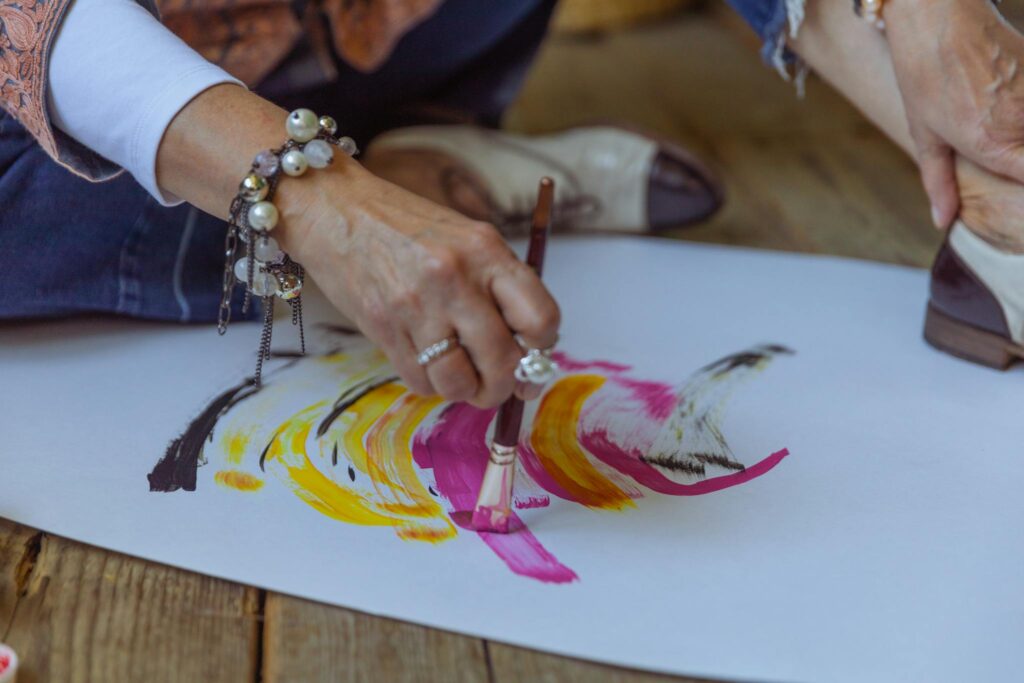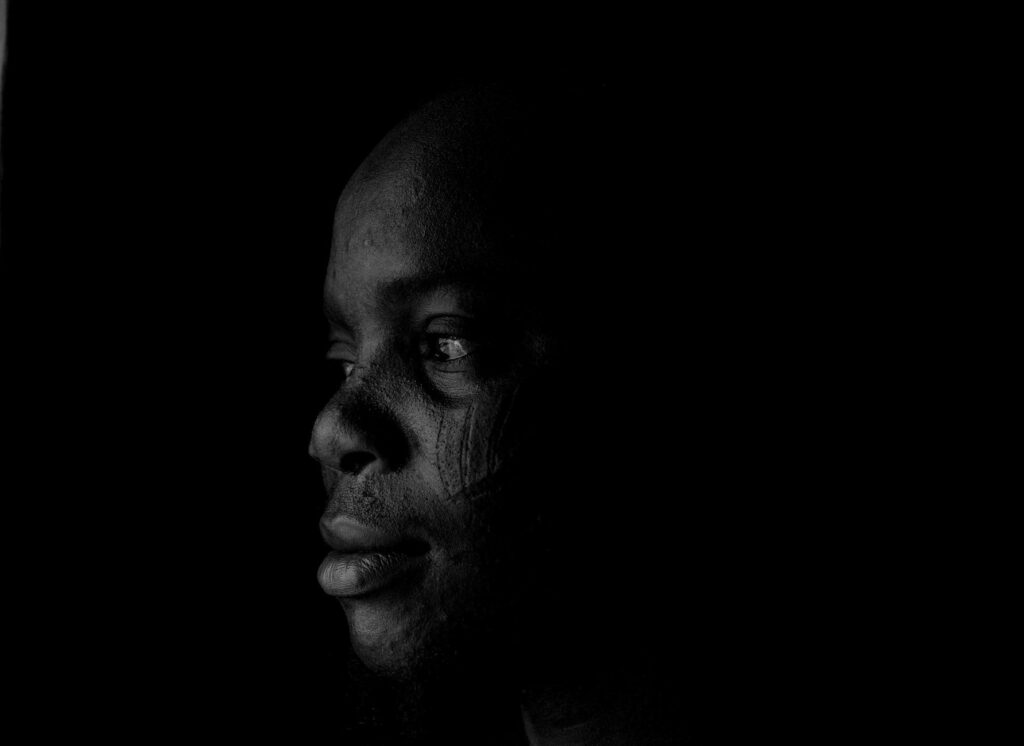How to Build a Creative Business Around Your Passion – 5 Keys
Starting a creative business can feel like walking a tightrope. On one side, there’s your passion, the very reason you picked up the paintbrush, microphone, pen, or camera. On the other, there’s the pressure to make it “work,” to figure out how to turn your art into something sustainable, or to even call it a business. For many emerging artists, writers, musicians, or creative souls, that tension feels heavy, like you’re juggling two worlds that don’t always understand each other.
I know that fear well: What if trying to build a creative business pulls you away from your art? What if promoting your work, managing requests, or figuring out how to make money for your craft dims the spark that made you start creating in the first place? For sensitive creatives, this worry isn’t just intellectual, it’s felt physically, in your chest, your stomach, even your hands when you pick up your tools.
For a long time, I believed I had to put my art aside to “build the business first.” I thought that once the systems were in place, I could return to my creativity without distraction. But the truth is, that approach left me drained, uninspired, and disconnected from the very work that made me feel alive. I wasn’t just neglecting my art, I was neglecting myself.
The real magic happens when you flip the script: when your art leads, and your creative business becomes its support. Imagine a business not as a set of obligations or endless hustle, but as a structure that protects your time, nurtures your creativity, and amplifies your impact. This isn’t about chasing trends, pushing products, or fitting into a mold. It’s about creating something that serves your creative work, giving you freedom, space, and energy to do what you were born to do.
In this post, we’ll explore how to start and grow a creative business that doesn’t just survive financially but thrives alongside your artistry. You’ll discover practical steps, mindset shifts, and gentle strategies to honor your creative energy, introduce structures that feel natural rather than rigid, and connect authentically with the people who resonate with your work — all without losing sight of why you create.Whether you’re just starting out, unsure of how to turn your passion into a sustainable path, or seeking a more aligned approach as an experienced creative, this guide is for you. By the end, you’ll understand how to make your art the center of your creative business and let it guide every decision, so your business becomes a vessel for your passion, not a distraction from it.
How Do I Start a Creative Business Without Losing My Passion?
You can start a creative business without losing your passion by keeping your work at the center, starting small, protecting your energy, and letting joy guide every step. Your “business” doesn’t have to be complicated, it’s simply a supportive structure to help you create more freely and share your work with the world.
If you’re an artist, musician, writer, or any kind of creative soul, you’ve probably heard this advice: “Turn your passion into a business.”
It sounds exciting, but also a little scary. Because the last thing you want is to turn something you love into something that drains you. And that fear is valid.
The truth is, starting a creative business doesn’t have to mean leaving your passion behind. You don’t need a fully formed business, a perfect website, or a giant audience to begin. A creative business can start small, even before you’re “officially” a business, as a way to give yourself the space, resources, and freedom to create more of what lights you up.
- If you are interested in this topic, Checkout our weekly podcast! The theme of this week is:
The peak passion podcast // EP 015
“The Power of A Creative Business “
Here’s how to get started in a way that honors your passion from day one:
1. Anchor Yourself in Your Why
Before worrying about websites, social media, or pricing, ask yourself: Why do I create? Not just for money (though that matters), but at the deepest level. Maybe it’s to share beauty, tell stories, inspire others, or simply to express yourself fully.
When you root your creative work in that deeper purpose, every choice — from the projects you say yes to, to the small steps you take toward sharing your work — feels aligned. Your passion becomes the heart of everything you do, rather than something you “sell” or “package.”
2. Protect Your Creative Energy
It’s easy to get distracted by the idea of “business tasks” before you even need them. For many creatives, trying to do everything at once — social media, emails, online shops — can feel overwhelming.
Instead, protect your creative energy first. Schedule time doing the thing that lights you up the most, and treat it as non-negotiable. If you want, you can start writing down small, simple ways your passion might reach others — like sharing a few pieces with friends, hosting a mini workshop, or offering prints — without diving into complicated systems. Your creative spark is your most valuable resource — guard it.

3. Start Small, But Start
You don’t need a business plan, funding, or perfect branding to begin. Think of small, playful experiments: share a painting online, record a song, or write a short story for an audience of one. Notice what excites you and what resonates with people.
Starting small lets you grow organically, at your own pace. Every little step builds confidence, clarity, and momentum, laying the groundwork for a creative business that supports you, not overwhelms you.
4. Keep Joy at the Center
Always return to what makes your heart sing. If sharing your work starts to feel heavy or forced, pause. Make art for yourself. Experiment freely. Explore projects that feel aligned.
Because here’s the secret: the most successful creative businesses aren’t built on hustle or pressure. They’re built on joy, curiosity, and devotion to the work that first made you fall in love with your craft.
Bottom line: Building a creative business without losing your passion is absolutely possible — but only if you honor your energy, protect your why, and allow your art to lead the way.

What Are the First Steps to Building a Creative Business?
Start where your craft and your knowledge meet. You don’t need to monetize your passion directly. Instead, consider how others can experience what you already do best. Your skill, your perspective, your creative work, these are the bridge to a sustainable business that protects your vision while inviting others to engage with it.
The first steps to building a creative business are clarifying your vision, identifying who your work resonates with, starting simple, testing small offers, and creating consistent, sustainable habits.
By beginning with small, aligned actions, you can grow a business that supports your creativity rather than draining it.
If you’ve decided you want to share your creative work with the world and start supporting yourself through it, the first question is: Where do I start?
For many sensitive creatives, the internet is full of advice that can feel overwhelming. Endless branding blueprints, marketing funnels, and 12-step launch plans promise success. Too much structure too soon can freeze you in place. You may feel stuck, unsure of which path honors your creativity while still helping your vision grow.
The key is to start simple, aligned, and creation-first. Your creative business doesn’t need to be complicated or perfect. It needs to create a platform for your work, connect you with the people who truly resonate with it, and flow naturally around your energy, not suffocate it. When done right, your business becomes a vessel for your creative expression rather than a burden.
Start With Your Expertise
You already carry a skill, a perspective, a craft that is uniquely yours. This is the foundation. Instead of monetizing your creative output itself, think about how others can engage with your knowledge or approach. This could be a small workshop, an intimate online session, a limited collection, or a curated experience that reflects your perspective.
By sharing your expertise first, you create a bridge between your creative work and the people who will resonate with it. Your creations remain sacred, untouched, and alive, until you choose to share them fully. Meanwhile, your creative business grows organically, rooted in what you already know and love to do. You are not selling yourself or your work. You are inviting others to experience it in a way that feels aligned, meaningful, and sustainable.

From Expertise to Vision
Your expertise gives you a starting point, but your creative vision is what shapes the bigger picture. Clarifying what you create, why you create it, and who it’s for ensures that your business reflects your unique perspective, not someone else’s formula.
- Define Your Creative Vision and Niche
Your creations are the heartbeat of your business. Before thinking about sales, strategies, or marketing, get clear on what you produce, the emotions it carries, and who it touches. This clarity is not about limiting yourself — it’s about understanding your unique voice so your audience can connect deeply.
Ask yourself:
- What themes or emotions do I explore in my work?
- Who feels most impacted by my creations?
- If my work could speak, what would it say?
Answering these questions honestly allows your business to grow naturally around your creative expression. It becomes a reflection of your vision rather than a rigid plan to chase profits. This foundation guides aligned choices about collaborations, offers, and projects.
- Identify Your Ideal Audience
Think of your audience as real people who are moved by your work — not a faceless demographic chart.
Maybe it’s other creatives seeking inspiration, or people who want pieces that bring peace, joy, or nostalgia. Maybe it’s someone who has never felt truly seen until your creations spoke to them. The clearer you are about these people, the easier it becomes to communicate authentically.
When you understand your audience deeply, you don’t have to “sell” in a way that feels awkward. Your work naturally finds the people already aligned with your energy and vision.
- Set Up the Essentials
You don’t need a complex website or every social platform. Start with the basics that allow people to discover and experience your creative work:
- A simple website or portfolio page that showcases your creations beautifully
- One or two social platforms you enjoy using and can maintain consistently
- A way for people to contact you or join your email list
At this stage, your goal isn’t perfection — it’s visibility and connection. Your platform is a tool to share your creative work, test ideas, and create relationships, not a stressor that distracts you from producing.

- Test Aligned Offers
Instead of launching a massive collection, a full course, or a huge product line, start with small, intentional experiments:
- A limited print run
- A mini-workshop or online session
- A few custom commissions
Pay attention to what energizes you and resonates with your audience. These early experiments give you valuable insights without draining your energy. They allow your creative business to grow organically around what feels aligned rather than forcing your creations into a cookie-cutter model.
- Build Consistency, Not Chaos
Many sensitive creatives believe success comes from a single viral post or big launch. In reality, creative businesses are nurtured quietly, over time. Consistently showing up, sharing your work, telling your story, and offering your creations builds trust and connection.
Consistency doesn’t mean rigidity or exhaustion. It means creating a rhythm that respects your creative energy and your audience’s experience. By showing up sustainably, you slowly grow a community around your work that is both engaged and supportive.
Bottom line:
Start small, stay aligned, and let your creative vision guide your strategy. Clarify your vision, understand your audience, set up the essentials, experiment with offers, and create a consistent, sustainable rhythm. Build your business around your expertise first, and your creative work will flourish naturally while supporting you.

How Can I Balance Making Art and Running a Business?
Balancing your creative work with the practical side of running a business doesn’t mean splitting your day in half or forcing productivity. True balance comes from putting your creativity first, batching admin tasks, honoring your natural flow, and even turning business activities into extensions of your art. By working in creative seasons and integrating business into your process, you protect your energy, amplify your work, and build a sustainable creative career that feels joyful and aligned.
Once you begin sharing your creative work with the world, another question arises: How do I keep creating while also running a business? For many sensitive creatives, this feels like walking a tightrope. On one side is the deep joy of your craft, on the other the responsibility of keeping your work alive and reaching the people who value it.
Here’s the truth: balance isn’t about splitting your time evenly. It’s about protecting your creative energy and letting your business serve it, not compete with it. When you design your days with your art at the center, the business becomes a steady companion, a structure that amplifies your expression rather than drains it.
1. Schedule Your Creative Time First
Your creative work is the heartbeat of everything you do. Treat it as sacred. Block time for it before filling your calendar with emails, admin, or marketing. Protecting these hours ensures your art continues to grow and evolve. Without it, there is no business worth building.
Many creatives fall into the trap of prioritizing business tasks first, thinking that income or visibility comes before creation. But the opposite is true: your creative work fuels your business. Without it, there’s nothing worth sharing. Time-blocking ensures that your art has a guaranteed space to breathe, evolve, and shine.
2. Batch Your Admin Work
Tasks like email, social media, and invoices can scatter your focus if you do them in between creative moments. Instead, group them together into specific blocks a few times per week. Batching keeps the practical side contained and frees your mind for deeper creative flow.
3. Honor Your Natural Creative Flow
Not every day looks the same. Some mornings your inspiration is strong, other days it’s quieter. Work with these rhythms instead of against them. Use your peak energy for creating, and lighter moments for business tasks. Rest when you need to. Your sensitivity is not a weaknes… it’s a compass.

4. Let Business Become an Extension of Your Craft
Business doesn’t have to feel separate from your creative work. Think of newsletters, social posts, or even your website as new canvases for expression. Infuse them with your voice, your visuals, your perspective. When business tasks reflect your artistry, they stop feeling like chores and start feeling like part of the creative process.
5. Work in Creative Seasons
Many sustainable artists work in cycles. You might dedicate one season to immersive creation and another to sharing or connecting with your audience. This way, you don’t demand everything of yourself at once. Creative seasons give your work space to breathe while ensuring your business keeps flowing.
Bottom line:
Balancing art and business is a practice, not a destination. By scheduling your creative hours first, batching administrative work, honoring your flow, integrating business into your art, and working in creative seasons, you create a rhythm that allows both sides to thrive. When art leads and business supports, your creative energy stays alive, your work reaches the right people, and your business becomes a devoted ally to your passion — not a burden.
How Do Successful Artists Build Sustainable Careers?
A sustainable creative career is built on devotion, alignment, and well-being, not hustle. Successful artists show up consistently for their craft, build supportive communities, focus on aligned projects, stay open to experimentation, and protect their creative energy so their work can thrive for decades.
Building a creative business isn’t just about getting started, it’s about thriving over the long term. For sensitive creatives, sustainability means protecting your art, your energy, and your authenticity while still creating impact and, if you choose, income. I
t’s not about working harder, doing more, or hustling nonstop. Instead, it’s about devotion, alignment, and creating habits and systems that nurture your creativity and allow your art to flourish for years to come.

1. Consistent Practice
The heart of any sustainable creative career is showing up for your craft regularly. Even on days when inspiration feels distant, commit to creating. Creativity is like a muscle, it grows stronger with consistent exercise.
This doesn’t mean every session has to produce a masterpiece. Sometimes simply sketching, improvising, writing freely, or exploring new ideas is enough. These small, consistent actions accumulate into deep skill, confidence, and a body of work you can share with the world.
Remember: mastery comes from devotion, not occasional bursts of work. By honoring your practice every day, you stay connected to the joy and magic that made you a creative in the first place.
2. Build a Supportive Ecosystem
No artist thrives in isolation. Surround yourself with mentors, collaborators, and communities that nourish your growth. Seek out people who understand your artistic vision, challenge you to expand your craft, and cheer on your wins.
This ecosystem doesn’t need to be vast. Even a few trusted connections can offer invaluable guidance, honest feedback, and motivation. Collaborating with others can open new doors, inspire fresh ideas, and remind you that you don’t have to do it all alone.
Communities: whether online or in person, are especially powerful for creatives. They can provide encouragement when doubt creeps in, accountability when procrastination strikes, and inspiration when your well feels low.
3. Embrace Alignment, Not Hustle
Many artists mistake being busy for being productive. Sustainable creative careers are built on alignment, not relentless hustle. Focus your energy on projects that inspire you, energize you, and resonate with your vision.
Saying “no” is just as important as saying “yes.” Every opportunity you accept should either fuel your creativity, strengthen your skills, or deepen your connection with your audience.
When you prioritize alignment over activity, your work becomes magnetic. People sense your authenticity, and your energy attracts the right collaborators, clients, and audience. Over time, this approach not only preserves your well-being but also creates a thriving career built on genuine connections and meaningful work.
4. Experiment and Adapt
Flexibility is essential for a sustainable creative career. The creative world is ever-changing, and those who adapt thrive. Try new formats, explore different mediums, offer small workshops, or collaborate with fellow creatives.
View each experiment as a learning opportunity. Pay attention to what resonates with your audience, what excites you, and what feels aligned. Some projects will fail, and that’s okay. Each attempt teaches you more about yourself, your art, and your ideal audience.
Experimentation keeps your creative business fresh, relevant, and deeply connected to your evolving artistic vision. By staying curious and open, you allow your work to grow organically without forcing it into rigid structures.
5. Protect Your Creative and Emotional Health
Your creativity depends on your well-being. Prioritize self-care, set boundaries, and cultivate practices that center your mind, body, and heart — whether that’s meditation, journaling, breathwork, or simply taking a day to create with no agenda.
A healthy artist is not only more productive but also more inspired, authentic, and present in their work. Sustainability isn’t about output or visibility; it’s about protecting the source of your creativity so it can flourish indefinitely.
Bottom line:
Sustainable creative careers are built on devotion to your art first. By practicing consistently, surrounding yourself with supportive people, aligning projects with your energy, experimenting with intention, and protecting your well-being, you create a foundation that allows your creativity to thrive for decades. Your art deserves not only to be seen but to be nurtured, honored, and celebrated — and the right systems and habits make that possible.

What Mindset Shifts Do I Need to Build My Creative Business?
The biggest barrier to a thriving creative business isn’t strategy, it’s mindset. Success comes from believing that creativity and business can coexist, defining your own version of success, separating self-worth from output, and embracing experimentation. When your mindset is aligned, business becomes a tool to amplify your art, not a burden that drains it.
The biggest challenge in building a creative business isn’t strategy or tools, it’s mindset. How you think about your craft, your value, and your relationship to business will shape every decision you make. Shifting your mindset isn’t just a nice-to-have; it’s essential for creating a business that supports your creativity rather than drains it.
Creativity turns into a habit. You have to experience it every day; it’s a lifestyle.
1. Creativity and Business Can Coexist
Many artists fear that business will dilute their expression. But business can be a canvas too. Selling your creations, designing offers, or setting up systems doesn’t have to feel like a burden, it can be another medium for your creativity.
When you reframe entrepreneurship as a way to share your work, protect your energy, and connect with the people who will value it most, it stops being separate from your artistry. It becomes part of it. This shift allows you to embrace entrepreneurship not as a compromise, but as a way to amplify the impact of your art.
2. Define Your Own Version Of Success
Comparison is a thief of joy. There is no single path. Some creatives thrive by teaching, some by selling originals, some through collaborations.
The only definition of success that matters is your own. Ask yourself: What kind of creative life feels aligned? What lets me keep making work without burning out? When you set your own measures, you free yourself from external pressure and create space for your voice to grow stronger.
The key is to define success for yourself. What feels aligned with your vision? What allows you to keep creating without burning out? When you honor your unique path, you free yourself from external pressures and allow your creativity to flourish naturally.
3. Worthiness Isn’t Tied to Productivity
It’s easy to equate value with output, how many songs released, how many sales made, how many followers gained. But your worth as an artist is not tied to metrics or productivity.
When you believe your creativity is valuable simply because it exists, you stop creating from fear or urgency. You begin to create from joy, curiosity, and truth. This shift changes everything, your work resonates more deeply, and your business decisions come from alignment, not scarcity.

4. Embrace Experimentation and Growth
Mindset shifts are not once-and-done. They’re a living practice. As you and your work evolve, your beliefs must evolve too.
Give yourself permission to experiment, make mistakes, and adapt. Try new approaches, reflect on what energizes you, and let go of what doesn’t. Each experience, even the difficult ones, teaches you more about yourself, your audience, and the creative business that truly supports you.
5. Practices to Support Mindset Shifts
Implement daily or weekly practices to keep your mind aligned with your creative goals:
- Journaling prompts: Reflect on what energizes you, what drains you, and your vision for your art.
- Affirmations: Reinforce beliefs like “My art deserves to be seen” or “Creativity and business can thrive together.”
- Mindfulness or meditation: Stay grounded in your values and purpose.
Embodiment practices: Dance, move, or simply breathe — connect with your body to release tension and spark creativity.
Bottom line:
Mindset is the backbone of a thriving creative business. When you shift your beliefs around art, value, and success, everything else — strategy, offers, marketing — becomes easier and more aligned. By embracing these empowering mindsets, you create space for your art to lead, your business to support, and your creativity to flourish sustainably.

Your Art Deserves to Be Seen (And Supported)
If you’ve been afraid that building a business will dim your spark, let this be your reminder: you don’t have to choose between creativity and business. You can have both.
A creative business doesn’t mean selling out or pushing yourself harder. It’s not about abandoning what lights you up. It’s about building a container — a structure that protects your energy, sustains your life, and allows your work, skills, and perspective to reach the people who need them most. Think of it as a partnership: your creativity leads, your business supports.
Throughout this guide, you’ve learned how to:
- Anchor yourself in your why, so every decision feels aligned with your deeper purpose.
- Protect your energy, so your best work isn’t sacrificed to admin, marketing, or overwhelm.
- Take intentional first steps, from defining your vision to testing small, aligned offers.
- Build sustainability through practice, supportive networks, and projects that feel right.
- Shift your mindset, knowing that creativity and business can coexist, and that success looks different for everyone.
These aren’t quick fixes. They’re long-term foundations. They help you create a career, or a livelihood, that feels alive, joyful, and aligned with your values. By honoring your creativity as sacred and letting it guide your decisions, you naturally attract the right audience, collaborators, and opportunities without burning out or compromising what matters most.
Your creativity deserves to be shared. Whether that looks like your art, your craft, your knowledge, or your unique way of seeing the world, it holds value. A creative business, when built with intention, isn’t a distraction. It’s a devotion. A devotion to your work, your community, and yourself.
So here’s the invitation: take your next step in a way that feels aligned. Share a piece of work, set up a simple offer, or join a community that supports your journey. Every small action is part of an ecosystem that keeps your creativity alive and supported.
Your passion brought you here. Your creativity will guide you forward. And with the right mindset, intentional structure, and sustainable practices, your creative life doesn’t just survive, it thrives.








